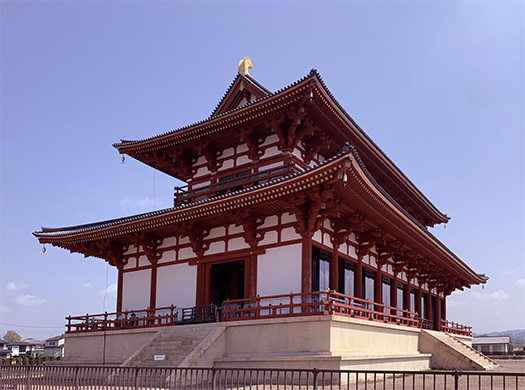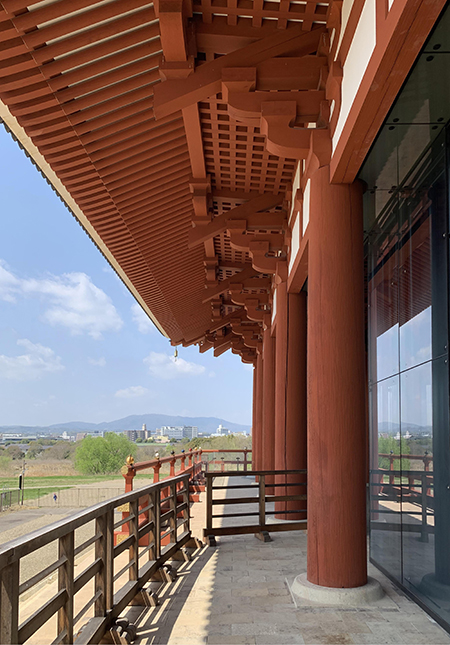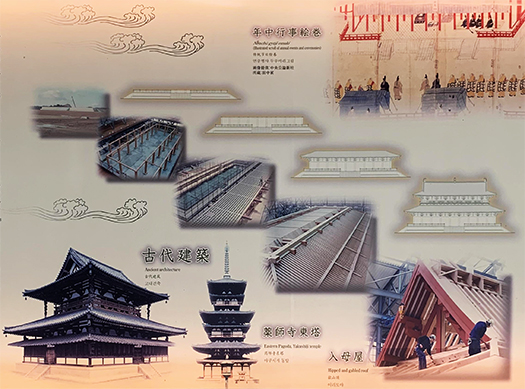


平城京建設は日本の中央集権国家建設と同義で同時進行した。
唐という強大な「近代国家」が成立し周辺諸国はその対応を迫られた。
百済という朝鮮半島国家は国家ごと消滅した。
日本は百済を救援したが白村江で敗北し、遺民は大挙して日本に帰化した。
そして国防意識が急速に高まって日本の中央集権化も進められ
律令という法整備が進み701年には租庸調の租税体系が整備された。
日本書紀などの国史編纂作業も進められた。
これらはまさに唐に対しての総合的国防を前提としたもの。
法制度があり、独自の歴史を持っていてなお
建築空間として「都」を造営してまつりごとの実質がある。
唐の側からしてインドとも同様の国家としての外交的立ち位置を認定した。
外交的接触機会を通して日本が「別の中華」として
中国王朝から独立的な国家として認定されていったのには、
この建築に於いて高い完成度を実現させたことが与っていたと思える。
藤原京に飽き足らずさらに平城京を造営し国事行為を視覚化していく。
この過程で全国の地域から租庸調が国に納税されたけれど、
全国で唯一、飛騨国は匠たちを派遣することで納税免除されていた。
かれらは古代官僚制国家機構で造宮省、木工寮、修理職などに配属された。
藤原京跡地に近い奈良県橿原市にはいまも「飛騨町」と地名が残る。
優れた技術の飛騨の匠により都には立派な建物ができ上がった。
あきらかに首都宮殿造営において集団的技術力で移住し勤務した。
飛騨は納める織物などは免除され、そのかわり1年に250日から300日間、
都へ行って宮殿や寺院などを造る大工仕事が課せられたという。
家50戸ごとに10人割り当てられ毎年100人前後の匠が都の造営へ出役した。
換算すると総戸数500戸で各戸8人と考えれば総人口4,000人程度だろうか。
戸という概念の特定も必要でありもっと多人数の単位かも知れない。
そこから成人男子100人の人間を送出していたことになる。
全国的にこの当時すでに飛騨の建築技術は抜群とされていた証拠。
したがっていま見られる平城宮復元建築もかれらの技術痕跡と思われる。


国家という形而上の物事に建築が深く関わっている実質を見る思い。
このことは、ではどうして飛騨国ではそういう技術があったのか、
という疑問につながっていく。
飛騨では縄文時代以来1万年程度の人間痕跡はわかると言われるけれど、
やはり木材資源の豊富さということが大きな要因かと。
この平城京の時代にそういう評価が存在したということは
さまざまな「木を扱う」技術蓄積が相当程度だったとみなせる。
それまでの建築からは想像を絶するような巨大で大量の建築需要が
必然的にかれらを欲したというように言えるのでしょうね。
いろいろ想像が膨らんできて面白い。
English version⬇
The Construction of a Nation and the Artisans of Hida: The Search for Heijo-kyo, Nara – 22]
The substance of the centralized state, the large-scale wooden architecture and its technical group that played a role in its “visualization. The fundamental meaning of architecture. …
The construction of Heijo-kyo Capital proceeded simultaneously with the establishment of a centralized state in Japan.
A powerful “modern state” called the Tang Dynasty was established, and neighboring countries were forced to respond.
The Korean peninsula state of Baekje was annihilated as a nation.
Japan rescued Baekje, but was defeated at the Baekchon River, and the survivors of the Japanese invasion were returned to Japan in droves.
The Japanese government rapidly became more aware of the need for national defense, and Japan’s centralization of power was promoted.
In 701, a system of taxation was established under the Ritsuryo (Laws of the Ritsuryo Period).
The compilation of national histories, such as the Nihon Shoki (Chronicles of Japan), also proceeded.
These were precisely based on the premise of comprehensive national defense against the Tang Dynasty.
Even though it had its own legal system and its own history
The Tang Dynasty had its own legal system and its own history, and yet it built a “capital” as an architectural space and had the substance of a festival.
The Tang Dynasty, for its part, recognized its diplomatic standing as a nation similar to that of India.
Through diplomatic contacts, Japan was recognized as “another China” and
The recognition of Japan as a nation independent of the Chinese dynasties was due in large part to the
The fact that Japan achieved a high degree of perfection in the construction of this building was a contributing factor.
Not content with the Fujiwara-kyo Capital, he built the Heijo-kyo Capital and began to visualize the conduct of state affairs.
In this process, taxation and taxes were paid to the government from all regions of Japan.
Hida was the only region in Japan that was exempted from paying taxes by dispatching artisans.
They were assigned to the Ministry of Palace Construction, the Woodworking Dormitory, and the Repairing Department in the ancient bureaucratic state structure.
The name “Hida-machi” still remains in Kashihara City, Nara Prefecture, near the site of the Fujiwara-kyo capital.
Hida’s excellent craftsmanship enabled the construction of magnificent buildings in the capital.
Hida was clearly the center of the capital’s palace construction, and the people of Hida migrated and worked there with their collective technical skills.
Hida were exempted from paying for textiles, but instead worked 250 to 300 days a year in the capital.
Instead, they were required to go to the capital 250 to 300 days a year to work as carpenters building palaces, temples, and other structures.
Every 50 households were assigned 10 carpenters, and about 100 carpenters went to the capital every year to work on the construction of the capital.
If we assume that the total number of houses was 500 and that each house had 8 workers, the total population would be about 4,000 people.
However, the concept of a “house” needs to be specified, and it may be a unit with a much larger number of people.
The total population of Hida was already 100 adult males at that time.
This is evidence that Hida’s architectural skills were already considered outstanding at that time.
Therefore, the reconstruction of the Heijo Palace is considered to be a trace of their technology.
The thought of seeing the substance of architecture deeply involved in the metaphysical things of a nation.
This leads to the question, “Why did the Hida region have such technology?
This leads to the question, “Why did the Hida region have such technology?
In Hida, it is said that traces of humans can be seen for about 10,000 years since the Jomon period.
I think the abundance of wood resources is a major factor.
The fact that such a reputation existed at the time of the Heijo-kyo Capital
The fact that such a reputation existed during the Heijo-kyo period indicates that there was a considerable accumulation of various “wood-handling” techniques.
The huge and massive demand for construction, which was unimaginable in the architecture of the time
It is interesting to see how the imagination is expanding.
It is interesting to imagine the various possibilities.
Posted on 5月 8th, 2022 by 三木 奎吾
Filed under: 住宅マーケティング, 日本社会・文化研究







コメントを投稿
「※誹謗中傷や、悪意のある書き込み、営利目的などのコメントを防ぐために、投稿された全てのコメントは一時的に保留されますのでご了承ください。」
You must be logged in to post a comment.